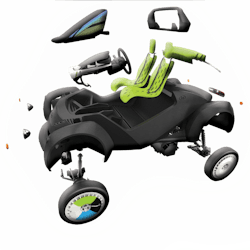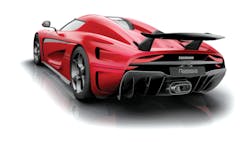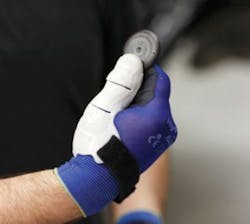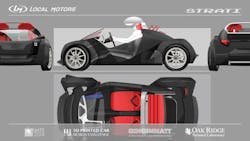There can be little doubt that additive manufacturing has become an important capability for automotive companies. A 2016 white paper1 addresses “Five ways 3D printing is transforming the automotive industry.” In the order given in the paper, the items are flexible optimized design, rapid tooling, fast customization, production aids, and real-world testing.
Prototyping is a well-established application area for 3D printing. The wide range of materials and virtually unlimited design complexity that the technology supports save manufacturers both time and money. Of course, prototypes are made so they can be further refined before committing to hard tooling for volume production. The relatively short time and low cost associated with iterating a printed design are revolutionary compared with previous methods.
Looked at one way, rapid tooling is self-explanatory: Other than the digital design file, there is no tooling. The term also relates to the capability to quickly create prototype tooling. For example, the white paper cites the use of 3D printing to generate molds that are used to make an initial run of parts. This approach can allow the prototype part to be made in the same way and same material as chosen for production parts. The mold design can be iterated as required before committing to steel tooling.
Until recently, the mention of custom parts might have brought to mind Jay Leno’s use of 3D printing to make no-longer-available parts for his large car collection. Today, it has become the preferred manufacturing method for low-volume high-end cars such as the Koenigsegg Automotive Regera shown in Figure 1. As described in another white paper,2 “Every Koenigsegg has at least 300 carbon-fiber components…. When you’re making the very best car in the world, then you simply have to make plastic models, test them, and make the final parts based on the results. Outsourcing this proved complex and delayed the whole production schedule.”
And, in another example, a recent Velocity network TV program included a distinctive emblem that in its original form wouldn’t fit a car’s custom paint job. To better suit the design, the part was scanned, digitally shrunk, and then 3D-printed. It still had all the characteristics that identified it with a particular car brand but in a smaller size.
Moving up in volume, a July 2016 Daimler press release describes the use of 3D printing by Mercedes-Benz Trucks, part of the Daimler Trucks Division, to generate spare parts. The release states “… Mercedes-Benz Trucks is using the latest 3D printing processes for plastic spare parts as the standard production method in the Customer Services & Parts sector. As of September, 30 genuine spare parts can be ordered and supplied at the press of a button from the 3D printer, quickly, economically, in any quantity, and always in consistent genuine manufacturer’s quality…. Today at Daimler, more than 100,000 printed prototype parts are manufactured for the individual company divisions every year.”
Reference 1 highlights the use of additive manufacturing to produce special production gauges and tools. In one case, a tier-one supplier “… developed a multifunction tool that can measure several points on a headlight or taillight prior to final assembly…. We came up with a triangle-shaped tool that … measures the edges, such as where the rubber connects to a taillight, to validate accuracy of the parts and fixtures.”
Courtesy of BMW
And, as described in Reference 2, BMW developed a thumb cast for assembly line workers (Figure 2). The white paper explains, “The workers have to push a huge number of rubber plugs into holes on the assembly line, which was giving too many of them a repetitive strain type injury…. A cast of the thumb and hand … took all the strain out of the process.”
The company’s website further elaborates, “Each of these finger cots is made specifically for its user. To this end, the worker’s thumb is measured with a mobile 3D hand scanner. Based on a standard production layout, the future orthotic device is then computed and divided virtually into individual layers. Layer by layer, each of them about as thick as a human hair, the tool is then manufactured in a selective laser sintering process. Put simply, the way this additive production procedure works is similar to a 3D printer: A digital data set is cut into individual layers of information. Based on the layer data, a plastic powder is selectively fused by a CO2 laser in a pre-heated construction chamber. This way, the plastic does not only mold into the layer presently created, but also merges with the previously formed one.”
Sometimes, prototypes need to achieve not just form and fit but function as well. This is what the last item in Reference 1’s list—real-world testing—refers to and has been made possible by a combination of new additive manufacturing technologies as well as the development of new materials. Before robust full-density metal parts could be 3D-printed, for example, plastic drivetrain parts could help convey a concept or prove that assembly could be correctly performed, but they didn’t actually work.
Functioning parts
Courtesy of EOS GmbH Electro Optical Systems
A good example of a component produced by direct metal laser sintering (DMLS) is a steering stub axle (Figure 3) developed by the Rennteam Uni Stuttgart, an independent club that takes part in the Formula Student race series across Europe.3 One of the club’s sponsors is EOS Electro Optical Systems, a developer of DMLS technology and a manufacturer of DMLS equipment.
As described on the EOS website, “The technology is of interest where a new approach to design and manufacturing is required so as to come up with solutions. It enables a design-driven manufacturing process—where design determines production and not the other way around. What is more, additive manufacturing allows for highly complex structures which can still be extremely light and stable. It provides a high degree of design freedom, the optimization and integration of functional features, the manufacture of small batch sizes at reasonable unit costs, and a high degree of product customization even in serial production.”
The Uni Stuttgart team already had a good stub axle design that was produced by precision casting. However, because the component adds to a car’s unsprung weight, reducing weight was desirable. Reference 3 continues, “As early as the conceptual design phase, the [student] engineers utilized the CAD software from Autodesk Within, whose programmers wrote their software specifically for the additive manufacturing process. The program makes possible the optimization of latticed microstructures of variable densities following examples found in nature. Thanks to this tool, the constructors were able to match the part perfectly to the structural requirements … [and achieve] light weight plus rigidity.”
In fact, the weight of the completed part was reduced by 35%—660 g—while its rigidity increased by 20%. Little rework other than minimal honing to fit the bearing was required after 3D printing was complete.
In Reference 2, further benefits of the EOS DMLS technology are highlighted. According to the white paper, the Williams Grand Prix Engineering Formula One team “… has made small parts in Alumide and CarbonMide for years, which allowed it to print everything up to and including full gearbox assemblies for functional testing and production aero parts.
To increase rapid manufacturing capabilities even further, “The British team took delivery of a large EOSINT 760 3D printer in December 2015 that allows it to print gearbox casings and more. These are race-ready parts that could take days and vast amounts of money to produce under the old system: Now they are ready within hours, and the company can constantly refine their concepts and print replacements.”2
The whole thing
Why not just print a complete car? The Strati shown in Figure 4, developed by Local Motors and built from scratch at IMTS 2014 in Chicago, is as much an example of a philosophy as it is a practical small vehicle. According to a January 2015 New York Times article4 that followed the 2014 IMTS exhibition by a few months, “… the body, frame, and interior were constructed from a carbon-polymer composite.” The Local Motors website further claims that 1,100 lb of carbon fiber-reinforced ABS are used in the vehicle. It takes 44 hours to print the single combined body-frame-interior piece and another day to mill the vehicle to tolerance.
Courtesy of Local Motors
A recent EE-Evaluation Engineering article5 includes details and comparisons of several additive manufacturing machines and processes. However, that article did not consider very large-scale applications and did not discuss the Big Area Additive Manufacturing (BAAM) machine installed at the Oak Ridge National Laboratory and built by Cincinnati,6 a build-to-order machine tool manufacturer.
As The Times article explains, from as early as 2007, John B. Rogers, founder and CEO of Local Motors, had been looking for a solution to what he considered to be a supply-chain problem. For Rogers, cars simply had too many separate parts, and each one had the potential to shut down production if it wasn’t delivered on time. Once Rogers saw the BAAM at Oak Ridge, he knew he had a solution.
The original BAAM had a build envelope of 6 ft x 12 ft x 3 ft and could print 10 lb per hour of the carbon fiber-reinforced material. More recently, a new BAAM has been developed with a 20 ft x 8 ft x 6 ft build volume and an extrusion system capable of depositing 100 lb per hour. The smaller BAAM manufactures the compact Strati main component to which the company adds an electric motor, suspension, and tires. The Times article quotes Rogers as saying, “The company plans to offer a vehicle that can be driven on all roads in the United States by 2017.… That would require passing safety requirements set by the National Highway Traffic Safety Administration, including crash tests.”6
There are even more revolutionary proposals being pursued. For example, BMW and Erik Melldahl, a Swedish designer, have proposed a 3D-printed concept car with a completely degradable main body made from a mixture of mycelium mushrooms and grass.7 The goal of the project is to explore ways to produce a sustainable, locally produced car—even in areas such as Africa’s Serengeti.
While some readers may think that this car is reminiscent of the East German cardboard Trabant from the late 1950s, this is a misconception. Like Melldalh’s car, the Trabant also was developed as the people’s affordable car, although the body was made from Duroplast—resin strengthened with recycled wool or cotton—not from cardboard. The material may have looked like cardboard after many years of use but actually remained very sturdy over a Trabant’s average lifespan of 28 years.8
A research report from the U.S. Department of Agriculture discusses applications in which ecologically friendly mycelium-reinforced composites can be used instead of inert plastics and expanded foam. As the report explains, “… [the process] involves using natural fibers that have been processed to a specific size range then sterilized to eliminate all biological [materials] that may exist. The sterilized fibers are then cooled and inoculated with a select fungal species. The inoculated fiber mix is used to fill a plastic mold (tool) in the desired shape of the final product. The tool is then sealed with a lid and placed in a shelving unit for two to three days until the mycelium covers the surface of the natural fibers. The part is then ejected from the tool and dried in an oven at 60 to 70°C for five to six hours. Once the parts exit the oven, the mycelium is dead and will not reanimate if it comes back into contact with moisture.” Today, this type of material is being used for packaging where a degree of cushioning is required. Advanced processing has produced higher density similar to pressboard, and other uses are being explored.9
The future
While a wide choice of highway-legal 3D-printed cars may be several years away, predicting other ways in which this technology may affect the automotive industry is fraught with uncertainty. It’s only been a couple of years since the BAAM machines and large DMLS machines became available, yet both already have had profound effects.
Being able to print replacement or even production parts as required is a game changer. It’s easy to see companies developing a range of initiatives similar to that undertaken by Mercedes-Benz Trucks that change the nature of the supply chain. For example, Local Motors is pursuing a network of what the company’s Rogers calls microfactories—the latest one being built outside of Washington, D.C. As The Times article explains, “Part retail store, part factory, the Washington plant will let consumers browse the designs, customize their cars, then have them created on one of the half-dozen industrial-grade 3D printers on site and assembled in a matter of days. ‘We like to think of it as Build-A-Bear, mashed up with Ikea, mashed up with Formula One,’ Mr. Rogers said.”4
References
- Five Ways 3D Printing is Transforming the Automotive Industry, stratasys, White Paper, 2016.
- Hall, N., Top 10 3D printed automotive industry innovations available right now, 3D Printing Industry, White Paper, June 20, 2016.
- “Automotive: Formula Student Germany—EOS supports racing team by producing a topology-optimized steering stub axle,” EOS, 2013.
- Kessler, A. M., “A 3-D Printed Car, Ready for the Road,” The New York Times, Jan. 15, 2015.
- Lecklider, T., “Building parts one layer at a time,” EE-Evaluation Engineering, August 2016, pp. 16-19.
- Krassenstein, B., “BAAM 3D Printer Gets Major Upfgrade—Prints 100 lbs of
Material Per Hour & More,” 3DPrint.com, March 19, 2015. - Milkert, H., “BMW Introduces Future 3D Printable Concept Vehicle Specifically Designed for the Serengiti,” 3DPrint.com, July 16, 2014.
- Hamer, T. and M., “The Trabant—Built Out of Plastic and Socialism,” About Autos.
- Holt, G. Ph.D., “Natural Fibers in Mycellium Reinforced Composites,” Cotton Production
and Processing Research Unit, Agricultural Research Service, U.S. Department of
Agriculture, May 2015.
For more information
About the Author






